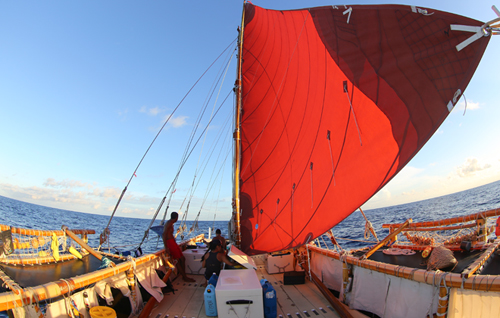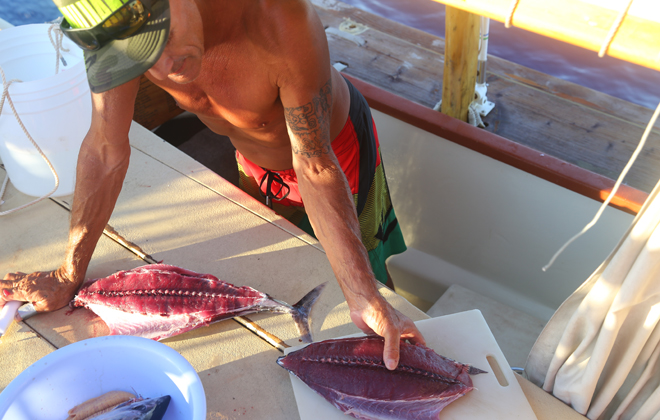Voyage of Pacific pride and concern

This is the view of the Hokule‘a’s deck you would see if you were on the steering sweep out at sea.

Watch captain and fisherman Timi Gilliom prepares a freshly caught aku on the decks of Hokule‘a

Hokule‘a captain Nainoa Thompson and crew member Junior “Rex” Lokeni man the hoe (sweep) to turn the canoe farther to port.

Nainoa Thompson uses his palm to measure distances on the horizon while aboard the voyaging canoe.

Hikianalia crew member Linda Furuto and watch captain Brad Wong share a laugh aboard the canoe as Wong strums an ukulele. During the most recent leg, Wong often would play music with the crew’s medical officer, Mel Chang, who accompanied on guitar.

Hokule'a sails in the waters off the tiny atoll of Swains’ Island, also known as Olohega, in the South Pacific.

Master navigators Nainoa Thompson and Kalepa Baybayan talk story with watch captains Timi Gilliom and Lehua Kamalu as Kawai Warren steers Hokule‘a to Pago Pago







One night several weeks ago, while on watch aboard the double-hulled voyaging canoe Hokule’a, navigator Kalepa Baybayan caught me not paying attention to the deck. Instead my eyes were glued to the sky.
But on a voyaging canoe that’s totally OK. In the remote Pacific there’s a moment after the sun sets and before the moon rises where the clear night sky is impossibly full of stars — so many that they blend into clouds streaking across the heavens. You can’t help but gape at what you’re seeing above.
Baybayan, a navigator-in-residence at the ‘Imiloa Astronomy Center, pointed at a patch of star cloud in between Hokule’a’s two masts.
"There," he said. "That’s the center of the Milky Way galaxy." Even in that one small glimpse of sky, there must have been millions of stars.
Baybayan just grinned as I tried to process it all. From an island canoe floating in a vast ocean wilderness, we gazed up in silence, trying to understand the significance of this tiny, fragile planet.
The third international leg of the Polynesian Voyaging Society’s three-year Malama Honua ("Care for the Earth") voyage wrapped up last week, and its crew is now doing what it can to adjust to life back at home after a hectic month abroad. Amid stubborn winds and tiny island communities still coping with disease outbreaks on their shores, Hokule’a and its escort vessel, Hikianalia, didn’t make it to all the destinations on their original sail plan.
Don't miss out on what's happening!
Stay in touch with breaking news, as it happens, conveniently in your email inbox. It's FREE!
Nonetheless, the crews of the "Samoa-Samoa" leg encountered some surprising, powerful and profound moments during the past four weeks in the South Pacific.
With a lot of hard work and minimal hours of sleep, they launched the voyage’s official campaign to educate the public about how critical the oceans are to sustaining life.
While keeping an eye to the stars, leaders also made an effort on the Samoa leg to "bring the voyage underwater," as Hokule’a captain Nainoa Thompson put it. They looked to raise awareness about runaway pollution, global sea rise, overfishing and other strains that are pushing the world’s ocean environments to the brink.
Crews surveyed the pristine, federally protected waters off American Samoa.
They met with influential leaders, including United Nations Secretary-General Ban Ki-moon. Hokule’a and Hikianalia crews had sailed through the night against rough seas to get to Ban, who was attending the U.N.’s Small Island Developing States Conference.
Aboard Hokule’a last month, as a hot sun glared down on Apia Harbor, Ban not only signed Hokule’a’s "Promise to Ka Pa’aina" (a document pledging to be a better environmental steward) — he also wrote a full message:
"I highly commend the Hokule’a and captain Thompson for the dedicated contribution to research and keeping our ocean environmentally sustainable. Let us work together to make this planet Earth sustainable!"
About two weeks after the SIDS conference ended, several hundred thousand people marched through the streets of New York to demand that world leaders take real action on climate change, during a subsequent U.N. summit that Ban led.
Meanwhile, back in Samoa, crew members encountered Republic of Kiribati President Anote Tong and a group of leaders from what Tong bluntly called the "coalition of sinking islands," as in the low-lying atolls threatened to be lost in the coming decades due to rising seas. Throughout the Samoa-Samoa leg a sad irony became clear: Many of the communities that have contributed the least to global warming will likely be hit first — and hardest.
It was apparent from the Samoa leg that Hokule’a remains a strong symbol of pride in the Pacific. During the past month, crews found that people wanted to feed them, heads of state wanted to host them, legislators wanted to honor them with proclamations and families wanted to pose for pictures in front of the wa’a (canoes).
On normally deserted Swains Island, the descendants of the last people to live on that pristine, virtually unknown atoll prepared coconut crab feasts and then stayed up for hours after dinner under the stars happily rehearsing a traditional dance from the Tokelau atoll chain with which to entertain the crew later. They humbly shared a glimpse of their culture with Hokule’a crews — and why they desperately want to hold on to it.
In Samoa, His Highness Tuiatua Tupua Tamasese Efi, the head of state, met with the crew several times and clearly struck a connection with Thompson. Efi also worries about different cultures fading across Polynesia.
Samoans in particular, he said, now "speak their culture in a whisper" compared with their ancient voyaging prowess. They’ll need to reclaim the values of the ancients, he said, if we’re to tackle the overwhelming environmental problems facing the present.
Thompson, often flanked by the iconic wa’a he navigated to Tahiti some 34 years ago, has clearly become a sort of unofficial emissary for Hawaii on these voyages. During the past month he would sometimes mention how hard he finds it to leave his family back home to lead these sails.
But he further feels that he has no right to complain about the direction the world is heading if he doesn’t try to change things.
"You can keep the canoes tied to the dock, but you can’t complain," Thompson told Efi and assembled guests at a dinner outside Apia.
And over dishes of sashimi and tempura at Sook’s Sushi in Pago Pago, American Samoa, Thompson met with local marine sanctuary officials to see how they could further strengthen their ties and continue to work together as the voyage continued — particularly once the canoes reach Aotearoa — the traditional name for New Zealand.
The big unknown is how these canoes will be received next year once they leave the familiar waters of the Pacific and enter for the Indian Ocean for the first time.
Sailing on these wa’a, your senses and your focus become sharper. Your awareness of your surroundings — not only on the canoe, but of natural cues — becomes stronger. You do what you can to take care of yourself and your fellow crew members and the canoe so that everyone can succeed.
The Samoa crews worked almost constantly to keep the wa’a safe and in working order — retying knots on the shrouds and stays to keep the masts secure, changing sails, climbing masts, loading dozens of food and water containers into stuffy hull chambers, cleaning the deck, checking the electrical systems — and myriad other tasks.
This crew, like most crews that will sail the canoes during the Malama Honua voyage in the coming years, hailed from diverse backgrounds.
Its 25 or so members included a sea captain from Maui, a mathematics professor at the University of Hawaii, a Hawaiian Airlines flight attendant, a former rugby player from Samoa, a psychologist and an aspiring wayfinding navigator from Japan, among others.
What tied them all together was simple: an abnormally strong work ethic and positive attitude. Those qualities weren’t just for window dressing or to make people feel good about the sail in some sort of "kumbaya" way. On a voyaging canoe, where crew members must rely on one another to safely travel and make landfall, those qualities become essential.
There was Hikianalia watch captain Brad Wong and medical officer Mel Chang strumming their ukulele and guitar, respectively, to entertain those on deck as the sun rises; Eric Co patiently showing the best knot to tie in a given situation (and there were lots of situations); apprentice navigators Lehua Kamalu and Jenna Ishii demonstrating true grit, manning the canoe around the clock — almost always with smiles on their faces; Keli Takenaga’s unbeatable cooking; Junior "Rex" Lokeni leaping across the deck to help take in a sail. Tim Gilliom’s rugged skill, particularly on the canoe sweep but pretty much handling any tough task onboard; Daniel Lin’s going above and beyond to get people where they need to go while in port; Cesi Ha’o sharing her homecoming; Baybayan serving as a mentor; Thompson, a teacher.
They and the rest of the crew are among the best representatives these Hawaiian Islands have to offer. I already miss them all terribly.

 Holy Week & Easter in Aiea || Free Events for All at OSHi! ️️
Holy Week & Easter in Aiea || Free Events for All at OSHi! ️️

